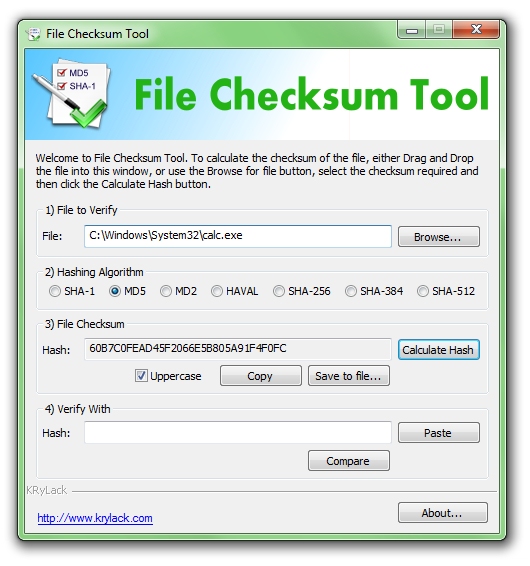

- How to check file hash algorith for free#
- How to check file hash algorith how to#
- How to check file hash algorith windows 10#
- How to check file hash algorith code#

For example, OpenBSD’s crypt(3) only supports Blowfish, which it identifies using the id “2b”. Other platforms support other algorithms, so check the crypt manpage there. Does Microsoft make available a utility to compute the SHA256 for a file, or do I need to.

How to check file hash algorith how to#
Some distributions use libxcrypt which supports and documents quite a few more methods: How to check SHA1 or SHA256 hash of downloaded Windows Update. So if a hashed password is stored in the above format, you can find the algorithm used by looking at the id otherwise it’s crypt’s default DES algorithm (with a 13-character hash), or “big” crypt’s DES (extended to support 128-character passwords, with hashes up to 178 characters in length), or BSDI extended DES (with a _ prefix followed by a 19-character hash). If you specify MD5 it creates an 5 object. This is a factory method that creates an instance of a hashing algorithm object. The MD5 hashing algorithm converts data into a string of 32 characters. In other words: A hashing algorithm is a one-way cryptographic function that generates an output of a fixed length (often shorter than the original input data). I found it surprisingly annoying to figure this out based on all the links talking about 'generating' a hash for use in new files and everyone talking about the built in FCIV and Sha1MD5. Hashing is a process that allows you to take plaintext data or files and apply a mathematical formula (i.e., hashing algorithm) to it to generate a random value of a specific length. These are the steps to perform in Chrome: The same results are shown in Firefox and Internet Explorer. That way, a received file can be authenticated as matching the original file that was sent, ensuring that the right files get where they need to go. This guide is to help you check the Hash of a single file to verify its integrity. How do I check my hashing algorithm The padlock in the browser address bar bears a lot of information about your certificate. You can use .Create () and specify the hashing method you want. MD5 runs entire files through a mathematical hashing algorithm to generate a signature that can be matched with an original file. Theįollowing values of id are supported: ID | Method Get checksum using any hashing algorithm. Id identifies the encryption method used instead of DES and this thenĭetermines how the rest of the password string is interpreted. If salt is a character string starting with the characters "$ id$"įollowed by a string optionally terminated by "$", then the result Those links are appropriate for modern Linux-based systems the description there is: Go to Tools > Hash Check, you will open the main screen of the free hash check tool like this.This is documented in crypt(3)’s manpage, which you can find via shadow(5)’s manpage, or passwd(5)’s.
How to check file hash algorith code#
Run the ShareX program on your PC, you’ll find it comes with many useful tools, such as Color Picker, Image Editor, Hash Check, QR Code Generator, etc.
How to check file hash algorith for free#
You can find more details and download it for free from this link. It is best known as free screen capture for Windows users. ShareX is an open source program for Windows. Select Windows R, press Enter, type Command Prompt, press Enter and repeat to run.
How to check file hash algorith windows 10#
In an earlier article, we demonstrated how to validate software downloads through checksums? Today, we will use another great file hash check in Windows 10 to show you how to check file hash, check MD5 hash, sha1 hash, sha-256 hash, sha-384 hash, sha-512 hash, etc. How Do I Find The Hash Of A File In Windows Make sure that the Windows command line is open. Once you have finished downloading a file onto your computer, check the file hash to ensure you get the exact copy of the file that has not been altered from the original. It is a string of text allow you to verify the integrity of the file downloaded from the Web. Sometimes when you download a software installer, you may see a SHA-1, SHA-256 or MD5 hash displayed.


 0 kommentar(er)
0 kommentar(er)
